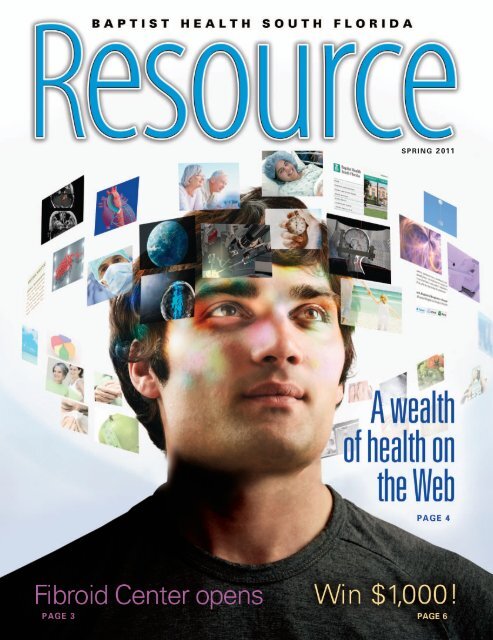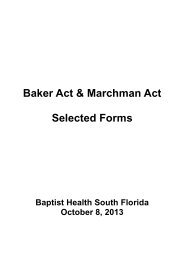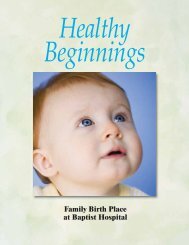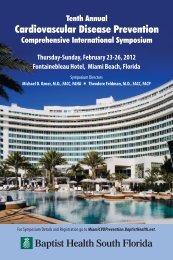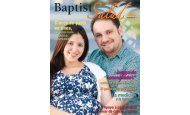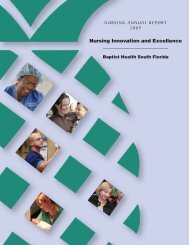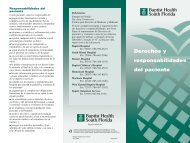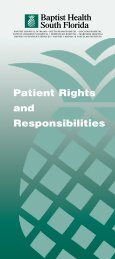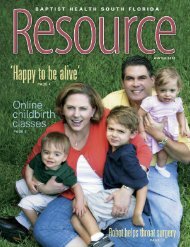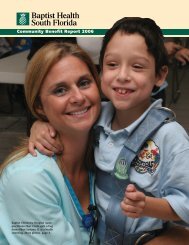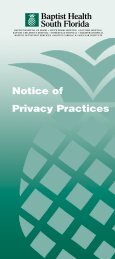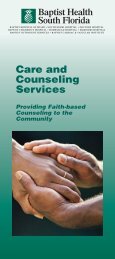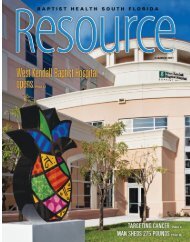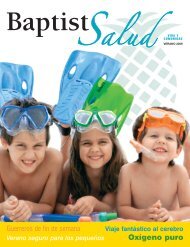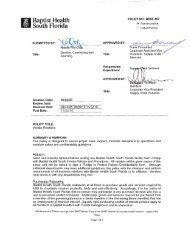SPRING 2011 - Baptist Health South Florida
SPRING 2011 - Baptist Health South Florida
SPRING 2011 - Baptist Health South Florida
Create successful ePaper yourself
Turn your PDF publications into a flip-book with our unique Google optimized e-Paper software.
<strong>SPRING</strong> <strong>2011</strong>
<strong>Baptist</strong> <strong>Health</strong> <strong>South</strong> <strong>Florida</strong> Chairman of the Board,<br />
Judge Robert Dubé; President, Brian E. Keeley. Trustees:<br />
Tony Alonso, Calvin Babcock, Yerby Barker, Wendell<br />
Beard, George Cadman III, James Carr, the Rev. William<br />
Chambers III, the Rev. David W. Cleeland, George Corrigan,<br />
William Dickinson, Joyce Elam, Herbert Greene, M.D.,<br />
George Harth, Jay Hershoff, Charles Hood III, the Rev. Dr.<br />
Gary Johnson, Norman Kenyon, M.D., Rudy Kranys, the<br />
Rev. Richard Ledgister, the Rev. Wilner Maxy, Paul May,<br />
the Rev. Dr. Marcos Ramos, Aida Shafer, Ronald Shuffield,<br />
Roberta Stokes, W. Peter Temling, the Rev. Tom Thompson,<br />
Bill Tillett, Scott Weston, the Rev. Dr. William White.<br />
<strong>Baptist</strong> Hospital of Miami Board Chair, Calvin Babcock;<br />
President, <strong>Baptist</strong> Hospital Medical Staff, Eugene Eisner,<br />
M.D.; Chief Executive Officer, Bo Boulenger.<br />
<strong>South</strong> Miami Hospital Board Chair, Yerby Barker;<br />
President, <strong>South</strong> Miami Hospital Medical Staff, Guillermo<br />
Pol, M.D.; Chief Executive Officer, Lincoln Mendez.<br />
Homestead Hospital Board Chair, the Rev. William<br />
Chambers III; President, Homestead Hospital Medical<br />
Staff, George Tershakovec, M.D.; Chief Executive Officer,<br />
William Duquette.<br />
Mariners Hospital Board Chair, Jay Hershoff; President,<br />
Mariners Hospital Medical Staff, Elisa Brown-Soltero, M.D.;<br />
Chief Executive Officer, Rick Freeburg.<br />
Doctors Hospital Board Chair, Norman Kenyon, M.D.;<br />
President, Doctors Hospital Medical Staff, Jack Cooper,<br />
M.D.; Chief Executive Officer, Nelson Lazo.<br />
<strong>Baptist</strong> Outpatient Services Board Chair, Roberta Stokes;<br />
Chief Executive Officer, Patricia Rosello.<br />
<strong>Baptist</strong> <strong>Health</strong> Enterprises Board Chair, James Carr;<br />
Chief Executive Officer, Ana Lopez-Blazquez.<br />
<strong>Baptist</strong> <strong>Health</strong> <strong>South</strong> <strong>Florida</strong> Foundation Board Chair,<br />
Rudy Kranys; Chief Executive Officer, Stephen Parsons.<br />
Directors of Affiliated Boards Yvette Aleman, Dick<br />
Anderson, George Aronoff, Orlando Bajos, James Barker,<br />
Matthew Becherer, Kerrin Bermont, Robert Berrin, Michael<br />
Bileca, Bonnie Blaire, James Boruszak, Steven Brodie,<br />
Bette Brown, Joseph Buchanan, Robert Burstein, Miguel<br />
Cano, Willie Carpenter, Mark Caruso, M.D., Gerald Case,<br />
Ray Castellanos, Mauricio Cayon, Barron Channer, Maria<br />
Costa-Smith, Augustin de Goytisolo, Elizabeth Diaz de<br />
Villegas, Lani Kahn Drody, Joyce Elam, Tomas Erban, Manuel<br />
Fernandez, Carlos Garcia, Peter Gardner, Maria Garza,<br />
William Gilbert Jr., Robert Gintel, Gretchen Goslin, Michael<br />
Graham, M.D., Leif Gunderson, Barry Halpern, M.D.,<br />
Kent Hamill, James Harris, Alysa Herman, M.D., Elizabeth<br />
Hernandez, Gerald Hirsch, Nathan Hirsch, M.D., G. Glenn<br />
Huber, Jacque Huttoe, Jeanne Jacobs, Ph.D., David<br />
Johnson, Lane Jones, S. Lawrence Kahn III, George Kakouris,<br />
George Knox, Manuel Lasaga, Katrina Lavene, Cynthia<br />
Leesfield, Maria Camila Leiva, Orlando Leon, M.D., Andrew<br />
Levy, James Loewenherz, M.D., Victoria London, Miriam<br />
Lopez, John Maas, Bruce MacArthur, Joseph McCain,<br />
DMD, Derek McDowell, Jo McGregor-Ganus, Stanley<br />
Margulies, M.D., Joy Martin, Charlie Martinez, Andrew<br />
Menachem, Hans Mueller, Patricia Mull, Ramon Oyarzun,<br />
Martha Pantin, Johanna Paterson, Ann Pope, Samuel<br />
Porco Jr., DMD, Juan-Carlos Quintero, DMD, Ramón Rasco,<br />
Charlen Regan, Ian Reiss, M.D., Bonnie Rippingille, Domingo<br />
Rodriguez, Gonzalo Sanabria, Steven Sapp, Joel Schenkman,<br />
M.D., Betty Schilling, I.E. Schilling, Robert Shafer Jr., Emery<br />
Sheer, Joel Shepherd, Karent Sierra, DDS, Paul Soulé,<br />
Patricia Stanley, Lee Stapleton, Rene Taylor, Patricia Thorp,<br />
Bill Tillett, Joseph Traina, M.D., Sats Tripathy, Nick Waddell,<br />
Jeff Weiner, Warren Weiser, Lisa White, William Wilson III,<br />
Robert Zolten, M.D., Leonard Zwerling, M.D.<br />
EDITOR Jo Baxter<br />
CONTRIBUTING EDITOR Patty Shillington<br />
ART DIRECTOR Elizabeth Lane Lawhorn<br />
WRITERS Liz Doup, Sheila Konczewski, Sharon Harvey<br />
Rosenberg, Elizabeth Rosenthal, Anne Streeter, Adrienne<br />
Sylver, Phyllis Teitelbaum, Tanya Walton<br />
EDITORIAL ASSISTANTS Georgette Koch, Barbara Moore,<br />
Dee Moustakas, Dorothy Stein<br />
PHOTOGRAPHY Mabel Rodriguez<br />
TO SEND COMMENTS, ADDRESS CHANGES OR TO UNSUBSCRIBE,<br />
E-MAIL MyResource @ baptisthealth.net<br />
6855 Red Road, Suite 600,Coral Gables, FL 33143<br />
baptisthealth.net
Women&<strong>Health</strong><br />
Fibroid Center offers team approach<br />
F<br />
or four years, Kimberly Mitchell suffered<br />
with symptoms caused by noncancerous<br />
growths known as uterine fibroids.<br />
Birth control pills no longer alleviated<br />
the breakthrough bleeding and lower<br />
back pain. And the fibroids kept growing.<br />
“I got discouraged and wasn’t sure<br />
what to do,” said Ms. Mitchell, a Miami<br />
mother of three. Then she discovered<br />
<strong>South</strong> Miami Hospital’s Fibroid Center,<br />
which opened last fall as part of the hospital’s<br />
Center for Women & Infants.<br />
The Fibroid Center offers women a<br />
unique, multispecialty approach to diagnosing<br />
and treating their problems, all in<br />
one location.<br />
“This is a one-stop shop and very convenient<br />
for the patient,” said gynecologist<br />
Rafael Perez, M.D., medical director of the<br />
Center. “Everything is done in one place with<br />
experienced physicians evaluating all the<br />
treatments and using the latest techniques.”<br />
The Center features a team of specialists<br />
including gynecologists, robotic surgeons,<br />
diagnostic and interventional radiologists<br />
and fertility specialists. Along with<br />
the women and their own doctors, these<br />
specialists work together to develop and<br />
implement a treatment plan tailored to<br />
each patient.<br />
“Historically, for a woman to get all her<br />
options, she had to go to two or three doctors,’’<br />
said interventional radiologist Adam<br />
Geronemus, M.D. “Ours is a team approach.<br />
After looking at all the patient’s information,<br />
Kimberly Mitchell discusses treatment options with<br />
Rafael Perez, M.D.<br />
we collaborate. We’re able to<br />
give her all her options.”<br />
Dealing with fibroids can<br />
be emotional for women,<br />
especially when they want a<br />
family. “Many women are<br />
concerned about retaining<br />
their fertility,” said reproductive<br />
endocrinologist Maria<br />
Bustillo, M.D. “We do a lot of<br />
handholding.’’<br />
As many as 50 to 80 percent<br />
of women develop<br />
fibroids during their lifetime,<br />
though not all experience<br />
symptoms. Because fibroids<br />
vary in size and location,<br />
symptoms and treatments<br />
vary. Symptoms range from<br />
severe menstrual cramps and<br />
painful intercourse to anemia<br />
and miscarriages.<br />
The Center’s specialists perform different<br />
treatments to shrink the growths,<br />
including fibroid embolization, laparoscopic<br />
or robotic myomectomy, which<br />
leaves the uterus intact; removal of the uterine<br />
lining; and laparoscopic or robotic hysterectomy,<br />
which removes the uterus.<br />
Most insurance plans cover the Center’s<br />
services. In addition, each doctor bills<br />
the patient’s insurance company. An evaluation<br />
and office visit with a nurse practitioner<br />
for those without insurance is $50.<br />
Ms. Mitchell, 34, found the Center efficient<br />
and the staff accommodating. Drs.<br />
Perez and Geronemus presented her with<br />
several options, explaining each in detail.<br />
She decided on a robot-assisted hysterectomy,<br />
which typically results in less scarring<br />
and postoperative pain and a quicker<br />
return to normal activities than a traditional<br />
hysterectomy.<br />
Before going to the Center, “I wasn’t<br />
aware of all the methods and technology,’’<br />
Ms. Mitchell said. “Now that I’ve learned so<br />
much, it helped in making my decision.”<br />
To contact the Fibroid Center, call<br />
786-662-8585. — Liz Doup<br />
BREAST MRIs MAY SAVE LIVES<br />
Annual MRIs plus mammograms and breast exams may help save lives of<br />
women at high risk for breast cancer — those with mutations in the BRCA1 or BRCA2 genes or with a family history of breast<br />
cancer. A Dutch study published in The Journal of Clinical Oncology is the first to measure whether adding MRIs to mammography<br />
screening increases survival.<br />
In 2,157 high-risk women, researchers found that after six years of the combined screenings, 93 percent of those with the<br />
gene mutation were alive, compared to 74 percent who were alive at five years in earlier studies without MRIs. In women<br />
with the BRCA1 mutation, MRI was superior to mammograms in finding cancer. All of those with family histories of<br />
breast cancer were still alive after six years.<br />
In recent years, annual breast MRIs along with mammograms have been recommended for those at increased risk for<br />
breast cancer. MRI is better at finding tumors, but mammography is also needed to detect cancers missed by MRI. Breast<br />
MRIs are not advised for women with average risk because of the chances for finding abnormalities that aren’t cancer, leading<br />
to unnecessary biopsies and repeat scans.<br />
Talk to your doctor about what breast cancer screening regimen is best for you. A prescription is needed. To make an appointment,<br />
call 786-573-6000 in Miami-Dade, 954-837-1000 in Broward or 305-434-1588 (mammography only) in Monroe County.<br />
—Anne Streeter<br />
RESOURCE 3
MAYBE YOU’RE CURIOUS about weight-loss<br />
surgery and wonder what the life-changing program entails.<br />
Perhaps your spouse needs a stent placed in a blocked artery<br />
following a heart attack and you want to know more about the<br />
procedure. Maybe you’re at your wit’s end with back pain.<br />
And what exactly is a Gamma Knife, now that your friend has<br />
been diagnosed with an inoperable brain tumor?<br />
If you’re like millions of American adults, you turn to the<br />
Internet for information about health and medical issues.<br />
Helen Gonzalez did just that when yo-yo dieting was complicating<br />
her weight problem and risking her health. She went<br />
online to learn about the surgical options and found Anthony<br />
Gonzalez, M.D., medical director of <strong>South</strong> Miami Hospital’s<br />
Weight-loss Surgery Program. The mother of nine children<br />
and stepchildren, Ms. Gonzalez agreed to contribute to <strong>Baptist</strong><br />
<strong>Health</strong>’s weight-loss surgery blog, Winning at Losing, in<br />
the hope that sharing her experiences would help others.<br />
Research suggests<br />
that healthcare websites<br />
and blogs increasingly<br />
do make a difference.<br />
Eight out of 10 Internet users — roughly 60 percent of<br />
American adults — sought health information online in 2010,<br />
according to a <strong>Health</strong> Topics report by the Pew Internet and<br />
American Life Project. A decade ago, only 25 percent of American<br />
adults relied on the Web for health information.<br />
In response to the expanding use of the Internet,<br />
<strong>Baptist</strong> <strong>Health</strong> has broadened its online offerings to<br />
help educate patients and healthcare consumers.<br />
“Today we’re dealing with a more educated consumer,<br />
which makes a better patient,” said cardiologist<br />
Ted Feldman, M.D., medical director of <strong>South</strong><br />
Miami Heart Center. “People are taking responsibility<br />
for their care. We’re giving people tools to get<br />
educated and deal with these issues in the comfort<br />
of their own home. It’s a very exciting time.”<br />
Many of <strong>Baptist</strong> <strong>Health</strong>’s websites feature medical<br />
libraries with multimedia presentations, including<br />
videos, podcasts, animations and interactive<br />
programs. These tools allow patients and consumers<br />
to research a wealth of topics and gain an under-<br />
Helen Gonzalez, who has lost more<br />
than 100 pounds, blogs about it at<br />
<strong>South</strong>MiamiWeightloss.com.<br />
A Wealth of <strong>Health</strong><br />
on the Web
A primer on websites<br />
standing beyond what words alone<br />
can impart. In addition, Internet users<br />
can watch moderated webcasts of surgical<br />
procedures at <strong>Baptist</strong> <strong>Health</strong> hospitals<br />
and can even take <strong>Baptist</strong> Hospital<br />
childbirth classes online.<br />
Stories about real-life patients and<br />
their treatments add personal insight<br />
to the websites, as do blogs about<br />
Ted Feldman, M.D.<br />
breast cancer and weight-loss surgery.<br />
“I hope that other people who have similar or different issues<br />
than I did will benefit from what I write,” said Ms. Gonzalez,<br />
46, who underwent weight-loss and gallbladder surgery last<br />
summer and had lost 100 pounds by the new year. “This has<br />
been life-changing for me.”<br />
In the end, these constantly evolving virtual elements combine<br />
with the potential to improve patient care, say <strong>Baptist</strong><br />
<strong>Health</strong> medical leaders.<br />
Indeed, a 2009 Pew report titled The Social Life of <strong>Health</strong><br />
Information found that so-called “e-patients” reported overwhelmingly<br />
positive experiences from seeking out health<br />
information online. Specifically:<br />
• 60 percent of e-patients say they or someone they know has<br />
been helped by health information discovered on the Internet.<br />
• 41 percent have turned to an online news group, website or<br />
blog to read health-related commentary.<br />
• 24 percent have gone online to<br />
check reviews of doctors.<br />
While the impact of online health<br />
information already is evident, it’s just<br />
the beginning, said Dr. Feldman and<br />
interventional radiologist Barry<br />
Katzen, M.D., founder and medical<br />
director of <strong>Baptist</strong> Cardiac & Vascular<br />
Barry Katzen, M.D.<br />
Institute. They envision using Internet<br />
technology to transform the way medical care is given,<br />
once the accepted standards of care in the practice of medicine<br />
catch up with technology.<br />
Dr. Katzen would like to see patients receive real-time<br />
e-reminders to take their medication, for example, because<br />
<strong>Baptist</strong> <strong>Health</strong>’s expanding set of websites offers education<br />
about medical conditions, treatment options and<br />
other clinical information. Here’s a primer on <strong>Baptist</strong><br />
<strong>Health</strong> websites:<br />
<strong>Baptist</strong><strong>Health</strong>.net and <strong>Baptist</strong>Salud.net: <strong>Baptist</strong> <strong>Health</strong>’s<br />
home website gives an overview of the largest not-forprofit<br />
healthcare organization in the region, with details<br />
about <strong>Baptist</strong> Hospital, <strong>Baptist</strong><br />
Children’s Hospital, <strong>South</strong><br />
Miami Hospital, Doctors Hospital,<br />
Homestead Hospital and<br />
Mariners Hospital. You can<br />
check estimated wait times at<br />
hospital emergency centers<br />
and <strong>Baptist</strong> Outpatient Services’<br />
urgent care centers.<br />
<strong>Baptist</strong>Heart.net, <strong>Baptist</strong>Corazon.net and <strong>South</strong>Miami-<br />
Heart.com: Learn about cardiovascular conditions and<br />
their treatments, from aortic aneurysms and peripheral<br />
artery disease to structural heart defects and irregular<br />
heartbeats. Meet the doctors and some of their patients.<br />
Find heart-healthy recipes and interactive tools to assess<br />
your risk, and make an appointment for a vascular<br />
screening.<br />
<strong>South</strong>MiamiWeightloss.com: Get information about<br />
obesity, the different types of weight-loss surgery and<br />
the process of becoming a candidate for the surgery.<br />
You can calculate your body mass index (BMI) and read<br />
Winning at Losing, the blog with entries from weightloss<br />
surgery patient Helen Gonzalez, as well as members<br />
of <strong>South</strong> Miami Hospital’s Weight-loss Surgery<br />
Program team.<br />
<strong>Baptist</strong>SpineCenter.com: Learn about conditions of the<br />
back and neck, and the conservative, multidisciplinary<br />
approach to treating back pain. Find out when minimally<br />
invasive surgery may be the best option.<br />
MiamiGammaKnifeCenter.com: Complete with stories<br />
and videos of patients, this website provides details<br />
about Gamma Knife radiosurgery — what it is (a noninvasive<br />
treatment) and when it’s used (for certain brain<br />
tumors, facial nerve pain, blood vessel abnormalities<br />
and other head and neck and neurological conditions).<br />
GetTreatedBetter.com, ConsientaseBien.com, KidsGet-<br />
TreatedBetter.com and ConsientalosBien.com: These<br />
sites provide details about urgent care and diagnostic<br />
imaging tests, such as MRI, CT scan and mammography.<br />
BreastCancerHealingJourney.com: This blog, Healing<br />
Journeys, features posts from a breast cancer survivor<br />
and links to cancer information.<br />
Continued on page 6<br />
RESOURCE 5
Continued from page 5<br />
noncompliance with medication instructions is the top reason<br />
that medication therapy fails. Patients could report symptoms,<br />
ask questions and receive responses quickly and efficiently. In<br />
turn, the Institute would be better able to follow up on patients.<br />
“We’re interested in Internet tools that will allow us to communicate<br />
with patients through e-mail and PDA applications,” Dr.<br />
Katzen said. “I think we can use these websites to increase our link<br />
to our patients — not just providing them with information but<br />
proactively interacting with them to improve their health and get<br />
involved in the care cycle.”<br />
A big part of Dr. Feldman’s practice at <strong>South</strong> Miami Heart<br />
Center is preventive cardiology, in which he counsels patients<br />
about how to better control their cholesterol, blood pressure and<br />
other cardiovascular indicators. He pictures Web conferences<br />
with patients, when appropriate, allowing him to practice cardiology<br />
in a more safe, environmentally responsible and cost-effective<br />
manner.<br />
“Much of what I do is consultations — talking to people about<br />
lifestyle changes, side effects of medications, the risks and benefits<br />
of surgery. You could charge less, be more efficient and more<br />
green. Patients would love it.<br />
“It’s just a matter of time,” Dr. Feldman said, “before the Web<br />
becomes a place where people receive medical care.”<br />
—Patty Shillington<br />
Stay in touch — with us.<br />
It’s more important than ever to stay connected. That’s why you’ll find free Wi-Fi at all<br />
<strong>Baptist</strong> <strong>Health</strong> hospitals, medical plazas and facilities.<br />
It’s just one of the many ways <strong>Baptist</strong> <strong>Health</strong> is connected to our patients. We employ the<br />
latest technology to keep tabs on your medication and the status of your health. And our eICU<br />
LifeGuard allows specialists to closely monitor intensive care patients 24/7.<br />
We keep in touch with the latest trends in technology. That’s why we never lose touch<br />
with you — follow <strong>Baptist</strong> <strong>Health</strong>SF on Facebook, Twitter and YouTube.<br />
baptisthealth.net<br />
6 RESOURCE
Grab your mouse.<br />
Prepare for surgery.<br />
Life-preserving<br />
Lung Cancer Surgery<br />
4 p.m.<br />
Thursday, June 16<br />
<strong>Baptist</strong><strong>Health</strong>.net<br />
(in English)<br />
<strong>Baptist</strong>Salud.net<br />
(in Spanish)<br />
Witness robotic surgery in<br />
action. <strong>Baptist</strong> <strong>Health</strong> Cardiac<br />
& Thoracic Surgical Group<br />
surgeon Mark Dylewski, M.D., will use<br />
the da Vinci robot to perform surgery<br />
to treat early-stage lung cancer.<br />
The surgery is minimally invasive.<br />
That means shorter recovery time, allowing<br />
the patient to resume a normal lifestyle<br />
more quickly, with less pain. In addition to<br />
the surgery itself, you’ll hear from a patient<br />
who has previously undergone the procedure.<br />
Join the webcast, presented in English<br />
and Spanish, and prepare to be fascinated.<br />
Thoracic surgeon Mark Dylewski, M.D.<br />
U.S. 1 and SW 62 Avenue<br />
Committed to our faith-based charitable mission of medical excellence
KidStuff<br />
Intervene to stop bullying<br />
Tyler Clementi, 18. Seth Walsh, 13. Phoebe Prince, 15. Hope Witsell,<br />
13. Billy Lucas, 15. One was a talented violinist, another<br />
loved to show horses. We will never know, however, who these<br />
teens would have become because each one committed suicide<br />
after relentless bullying.<br />
The issue of bullying has received significant attention lately<br />
due to the rash of suicides by victims, but The Melissa Institute for<br />
Violence Prevention and Treatment has been helping kids and<br />
adults put an end to bullying for more than a decade.<br />
The Institute held two educational programs on bullying last<br />
fall — Banishing Bullying, a <strong>Baptist</strong> Children’s Hospital parenting<br />
class, and another program attended by more than 230 public<br />
school psychologists, social workers and counselors.<br />
“It’s important to understand that all bullying, whether it’s<br />
“It’s important to understand<br />
that all bullying ... requires adult<br />
intervention and assistance.”<br />
— Trish Ramsey, The Melissa Institute<br />
for Violence Prevention<br />
direct like hitting, kicking or taunting; or indirect, like spreading<br />
rumors, causing a person to be socially isolated or cyber-bullying,<br />
requires adult intervention and assistance,” said Trish Ramsay,<br />
education director of The Melissa Institute.<br />
“Bullying is a relationship problem that requires relationship<br />
solutions in all of the places where children live, learn, play and<br />
work,” said Debra Pepler, Ph.D., a member of the Institute’s Scientific<br />
Board and a distinguished research professor of psychology at<br />
York University in Toronto. Research has shown, she added, that<br />
when someone intervenes, bullying stops within 10 seconds in<br />
half of all cases.<br />
Support is necessary for the bully, the victim and the bystander.<br />
The bully needs to understand the impact of his or her behavior<br />
and find ways to achieve power and status through positive leadership.<br />
The victim needs protection and support<br />
in developing confidence and positive<br />
friendships. The bystanders need to recognize<br />
that inaction contributes to the problem<br />
and that there are ways they can stop<br />
bullying and support their peers.<br />
“Telling is not the same thing as tattling,”<br />
Ms. Ramsay said. “Telling will get someone<br />
out of trouble. Tattling is designed to get<br />
someone into trouble.”<br />
One mother at the parenting program<br />
said she was worried that her son would be<br />
bullied after they move this summer and he<br />
begins middle school in a new town. His<br />
height, far above that of his peers, she said,<br />
might make him a target.<br />
Ms. Ramsay advised the mother that role<br />
HEART DISEASE STARTS IN CHILDHOOD<br />
Parents concerned about their children’s health can add<br />
another worry to their list: heart disease. Research shows it<br />
starts in childhood.<br />
But the child who develops heart-healthy habits as a youngster<br />
or adolescent may reap benefits in adulthood, according to<br />
two new studies published in the American Heart Association<br />
journal Circulation.<br />
“This is exciting because we could be preventing cardiovascular<br />
disease later on by intervening early,’’ said Madeleen<br />
Mas, M.D., a pediatric cardiologist at <strong>Baptist</strong> Children’s Hospital.<br />
Cardiovascular disease remains the top cause of death in<br />
men and women in this country. Because obesity is linked to<br />
heart disease, physicians worry that the epidemic of overweight<br />
children portends a future explosion of cardiac problems,<br />
Dr. Mas said.<br />
One study suggests that the presence<br />
of such risk factors as abnormal<br />
cholesterol and high blood pressure<br />
by around age 9 strongly<br />
predicts that the neck artery walls<br />
will thicken by early adulthood. That<br />
thickening is a precursor to strokes and<br />
heart attacks.<br />
As a result, it’s important for parents to<br />
schedule a heart-risk evaluation for their child if a<br />
pediatrician already hasn’t suggested it, Dr. Mas said.<br />
These evaluations typically include questions about diet<br />
and exercise as well as checking the child’s cholesterol,<br />
blood pressure and body mass index, which measures weight<br />
in relation to height.<br />
If a problem exists, initial treatment focuses on lifestyle<br />
8 RESOURCE
All about kids<br />
playing could help her son stand tall and exude confidence, making<br />
it less likely that he will be bullied. In addition, she suggested the<br />
mother work to find a friend or two for her son before the school<br />
year starts.<br />
“Unfortunately, there’s not one answer that fits every situation,”<br />
Ms. Ramsay said.<br />
There may be times when it’s easy to find an adult or teacher for<br />
help; at other times, a bystander may defuse the situation by asking<br />
the victim to join him or her and walk away.<br />
Cyberbullying, or bullying that occurs online or through texting<br />
or other electronic means, can be very destructive, said Wendy<br />
Craig, Ph.D., a psychology professor at Queen’s University in<br />
Ontario and also a member of the Institute’s Scientific Board.<br />
“Technology is here to stay, and yet as adults and experts we are<br />
often behind our kids in Internet knowledge,” Ms. Craig said. “Kids<br />
can be bullied 24/7 now.” Because messages on Facebook, in Internet<br />
polls, on blogs and in texts stay in place, a child is bullied each<br />
time someone sees the original statement or threat.<br />
The experts agreed that parents, teachers and counselors need<br />
to be aware of bullying and the resources that are available to them,<br />
and that children, no matter if they are the bully or the victim,<br />
must get help.<br />
“We’re here to say that bullying must stop because there are<br />
children who are tormented to the point where they take their own<br />
lives,” Ms. Ramsay said. “And we’re here to say that bullying must<br />
stop because many children who bully turn into aggressive, violent<br />
adults.”<br />
For more details about bullying, go to melissainstitute.org,<br />
stopbullyingnow.hrsa.gov or stopcyberbullying.org.<br />
—Adrienne Sylver and Sharon Harvey Rosenberg<br />
changes — diet and exercise — not medication,<br />
Dr. Mas said.<br />
Indeed, changing unhealthy habits can make a<br />
difference. The second research study found that<br />
children who ate fruits and vegetables once a day<br />
had healthier arteries as young adults than children<br />
who consumed fruits and vegetables less than<br />
twice a month. The lower consumption was linked to<br />
stiffening arteries, a red flag for future heart problems.<br />
Parents concerned about their children’s heart health<br />
should set a good example by serving whole grains, fruits<br />
and vegetables, Dr. Mas said. Regular exercise that includes<br />
aerobic activities such as running, cycling or swimming is<br />
also good for the heart.<br />
“Eating healthy and exercising need to be part of a routine,”<br />
she said. “Just like brushing your hair or teeth.” —Liz Doup<br />
Join the parenting experts at <strong>Baptist</strong> Children’s Hospital for<br />
enlightening conversation and practical advice. Each program<br />
is held in the auditorium at <strong>Baptist</strong> Hospital and costs<br />
$5, unless otherwise noted. Programs are not intended for<br />
children, unless indicated. You must reserve your space by calling<br />
786-596-3812.<br />
BUILDING SELF-ESTEEM IN YOUR CHILDREN<br />
Thursday, March 24, 7-9 p.m. Whether they’re starting a<br />
new school, performing onstage, competing in<br />
sports or socializing with friends, it takes confidence<br />
to be a kid! Psychologist Andrew<br />
Lagomasino, Psy.D., helps parents learn to<br />
instill confidence in their children so they can<br />
believe in themselves while taking on life’s<br />
challenges. For parents of school-age kids.<br />
WHAT’S HAPPENING TO ME?<br />
Thursday, April 7, 7- 8:30 p.m., Children’s Diagnostic<br />
Center at Country Walk, 13500 SW 152 Street<br />
Yesterday she had training wheels. Today she has a training<br />
bra. What will tomorrow bring? Yvonne Brookes, R.N.,<br />
helps girls prepare for the changes they’ll face as their<br />
body matures from a child into an adult. For girls age<br />
8 –11. This program is FREE.<br />
RESPONSIBLE PARENTING<br />
Thursday, April 28, 7-9 p.m. Is your toddler<br />
testing you with temper tantrums?<br />
Is bedtime a nightly battle? Are your teens<br />
breaking curfew or talking back? Join<br />
psychologist Richard Toister, Ph.D., for tips to<br />
help you effectively discipline your child and<br />
manage the daily challenges and responsibilities of<br />
parenthood. For parents of kids of all ages.<br />
AGES AND STAGES: PLANNING FOR CHANGES<br />
Thursday, May 26, 7-9 p.m. New friends, new teachers,<br />
new beginnings, new worries… Whether your<br />
toddler is beginning kindergarten, your<br />
elementary student is moving on to middle<br />
school, or your teen is about to start high<br />
school, it can be a time of mixed emotions.<br />
Psychologist Kaia Calbeck, Ph.D., helps<br />
parents and students transition smoothly. For<br />
parents of preschool through high school students.<br />
8900 North Kendall Drive<br />
RESOURCE 9
Senior{Focus<br />
CT screening cuts lung cancer deaths<br />
Former or current smokers should take note of a recent study<br />
that found that those who were screened annually with lowdose<br />
spiral CT (computed tomography) scans had a 20 percent<br />
lower risk of dying from lung cancer than those screened<br />
with conventional chest X-rays.<br />
The results of the study were so compelling that the landmark<br />
National Lung Screening Trial (NLST) was stopped and the preliminary<br />
results reported.<br />
“These findings are significant since it appears that yearly<br />
screening with low-dose CT imaging can save lives of seemingly<br />
healthy people who have a history of<br />
heavy smoking,” said <strong>Baptist</strong> Hospital<br />
Chief of Radiology Jack Ziffer, M.D., Ph.D.<br />
“Reducing lung cancer mortality by 20<br />
percent will make a huge difference in<br />
sparing patients and their families from<br />
the devastation caused by this disease.”<br />
The National Cancer Institute, sponsor<br />
of the study, estimates that more than<br />
94 million current and former smokers<br />
in the United States are at high risk for<br />
Jack Ziffer, M.D.,Ph.D.<br />
lung cancer. In 2010, an estimated<br />
222,520 people were diagnosed with, and 157,300 died of, cancer<br />
of the lung and bronchus. Cigarette smoking is the most important<br />
risk factor, though lung cancer strikes some nonsmokers.<br />
Chest X-rays have long been used by doctors to look for signs<br />
of lung cancer in those patients with symptoms. But chest X-ray<br />
screening hasn’t reduced lung cancer deaths.<br />
Because CT can pick up much smaller tumors than X-rays, the<br />
newer technology has been proposed as a life-saving screening<br />
tool. Researchers wanted to find out if finding tumors earlier with<br />
CT would increase the odds of surviving lung cancer.<br />
The NLST, launched in 2002, focused on 53,454 former and<br />
current heavy smokers ages 55 to 74. Participants had smoked at<br />
least 30 “pack years” — one pack a day for 30 years, two packs a day<br />
for 15 years, or three packs a day for at least 10 years. Former smokers<br />
were included if they were 30 pack-year smokers who had<br />
Compared to a one-way view of the lungs from the front or side<br />
in a conventional chest X-ray (left), a low-dose CT lung scan gives<br />
cross-sectional images from many different directions that can<br />
be manipulated by radiologists for a more detailed analysis.<br />
stopped smoking within the previous 15 years.<br />
Participants at 33 American sites were randomly assigned to<br />
undergo either annual screening with CT scans or traditional<br />
chest X-rays for three years. After the three rounds of screening,<br />
the participants were to be followed for five years.<br />
There were 354 deaths in the CT group and 442 in the chest<br />
X-ray group. Of those screened with CT, 24 percent had a positive<br />
finding for an abnormality, compared to nearly 7 percent of those<br />
screened with X-ray. Follow-up tests, such as invasive biopsies,<br />
found no signs of cancer in the majority of those people whose CT<br />
or X-ray results indicated a possible abnormality.<br />
“This study only looked at current and past heavy smokers —<br />
those at highest risk for developing lung cancer,” Dr. Ziffer said.<br />
“The results of this trial will be used to develop national screening<br />
guidelines that will weigh the potential for saving lives against the<br />
disadvantages associated with the high rate of false-positive findings,<br />
and concerns for the cumulative effects of radiation from<br />
multiple CT scans — though the dose used for screening is much<br />
less than that used for diagnostic imaging.”<br />
Experts agree that the best way to prevent lung cancer is to never<br />
start smoking, or if already smoking, to quit. If you are concerned<br />
about your risk for lung cancer, talk to your doctor. — Anne Streeter<br />
HOW TO GET A LUNG, HEART SCREENING<br />
If you are at risk for lung disease or a heart attack, you may benefit from one or both of the following CT screening scans:<br />
• CT lung screening scans look for early signs of lung cancer and other abnormalities (see story above).<br />
• CT calcium scoring scans measure the buildup of calcium on the walls of coronary arteries, a sign of heart disease and<br />
potential heart attacks.<br />
Talk to your doctor about the benefits of these tests if you are over age 40; if you have diabetes, high blood pressure or high<br />
cholesterol, or have ever smoked; or if you have a family history of heart disease or lung cancer.<br />
A doctor’s prescription is required to schedule CT scans. If you need a physician, call <strong>Baptist</strong> <strong>Health</strong>’s free Physician Referral<br />
Service at 786-596-6557 in Miami-Dade or 954-837-1200 in Broward. To schedule an appointment, call 786-573-6000 in Miami-<br />
Dade or 954-837-1000 in Broward.<br />
The cost of a CT calcium scoring scan is $120; $250 for CT lung screening. If both tests are done on the same day, the total<br />
cost is $295. Insurance does not typically cover the cost of these tests.<br />
10 RESOURCE
SeniorCalendar<br />
March, April & May<br />
If you’re 55 or older, take advantage of the programs and health screenings offered by <strong>Baptist</strong> <strong>Health</strong> just for you. Programs are free<br />
(unless otherwise noted). Space is limited and registration is required for all programs. A tour of the host facility may follow. For programs<br />
in English, call 786-596-3812; for programs in Spanish, call 786-596-3814; or e-mail us at programs@baptisthealth.net. For more<br />
information on other <strong>Baptist</strong> <strong>Health</strong> programs, visit baptisthealth.net.<br />
<strong>Baptist</strong> Medical Plaza at Doral<br />
9915 NW 41 Street, Suite 210<br />
<strong>Health</strong> Resource Center<br />
Ending Knee Pain With New Technology,<br />
Wednesday, March 9, 6:30-7:30 p.m.<br />
(in English), 7:30-8:30 p.m. (in Spanish),<br />
Dr. Rafael Fernandez, orthopedic surgeon.<br />
Sounds Right: Treating Hearing Disorders<br />
(in Spanish), Tuesday,<br />
March 29, 7-8 p.m., Dr.<br />
Alberto Fernandez,<br />
otolaryngologist.<br />
AARP Driver Safety<br />
Program, Friday,<br />
April 1, 9 a.m.- 4 p.m. Fee $12 for members,<br />
$14 for nonmembers. Call 305-857-0531<br />
to register.<br />
Prostate Prognosis: Tackling the<br />
Problems, Wednesday, April 13, 7-8 p.m.,<br />
Dr. Darren Bruck, urologist.<br />
Help for Incontinence (in Spanish),<br />
Tuesday, April 26, 7-8 p.m., Dr. Robert<br />
Santa-Cruz, urologist.<br />
Strike Back Against Stroke, Friday, May<br />
13, 1-2 p.m., Dr. Paul Damski, neurologist.<br />
Osteoporosis Screening, Saturday,<br />
May 21, 10a.m.-1 p.m., $5 May special.<br />
<strong>Baptist</strong> <strong>Health</strong> Resource<br />
Center at Informed Families<br />
2490 Coral Way, 2nd Floor<br />
Living With Shingles (in Spanish),<br />
Friday, March 18, 1-2 p.m.,<br />
Dr. Felipe Del Valle, internist.<br />
Mindful Eating, Monday, March 28,<br />
7-8 p.m., Dr. Patricia Isis, licensed mental<br />
health counselor.<br />
Home <strong>Health</strong>: Choosing the Right One<br />
(in Spanish), Friday, April 8, 1-2 p.m.,<br />
Elsa Ivonnet, registered nurse.<br />
Osteoporosis: Improving Your Bone<br />
<strong>Health</strong> (in Spanish), Thursday,<br />
April 14, 7-8 p.m., Dr. Rafael Fernandez,<br />
orthopedic surgeon.<br />
Beating the Cholesterol Battle<br />
(in Spanish), Tuesday, May 17, 7-8 p.m.,<br />
Dr. Jaime Ghitelman, cardiologist.<br />
Osteoporosis Screening, Wednesday,<br />
May 18, 12:30-2:30 p.m., $5 May special.<br />
<strong>Baptist</strong> Medical Plaza at<br />
Westchester<br />
8820 Bird Road, Suite 400<br />
<strong>Health</strong> Resource Center<br />
Memory Loss: Aging or Alzheimer’s?<br />
Thursday, March 10, 7-8 p.m.,<br />
Dr. Jorge Marcos, neurologist.<br />
Vein, Vein, Go Away (in Spanish),<br />
Wednesday, March 23, 7-8 p.m.,<br />
Dr. Juan Carlos Pereda, vascular surgeon.<br />
Dermatology: What’s New,<br />
Wednesday, April 6, 7-8 p.m., Dr. Ileana<br />
Perez-Quintero, dermatologist.<br />
Women’s <strong>Health</strong> Resource<br />
Center<br />
8950 N. Kendall Drive, Suite 105<br />
Osteoporosis: Beatable, Treatable,<br />
Tuesday, March 8, 7-8 p.m., Dr. Santiago<br />
De Solo, rheumatologist. Osteoporosis<br />
screenings available following program<br />
for $15.<br />
What You Need to Know About<br />
Kidney Stones, Tuesday, April 5, 7-8 p.m.,<br />
Dr. Yekutiel Sandman, urologist.<br />
Shoulder Surgery:<br />
Getting Back in the<br />
Game (in Spanish),<br />
Monday, April 11, 7-8<br />
p.m., Dr. David Font-<br />
Rodriguez, orthopedic<br />
surgeon.<br />
Osteoporosis Screening, Monday,<br />
May 16, 3-6 p.m., $5 May special.<br />
Memory Loss: Aging or Alzheimer’s?<br />
(in Spanish), Tuesday, May 24, 7-8 p.m.,<br />
Dr. Gonzalo Yanez, neurologist.<br />
Medical Arts Surgery Center at<br />
<strong>South</strong> Miami Hospital<br />
6200 Sunset Drive, Suite 200<br />
Options for Treating Bladder Prolapse<br />
(in Spanish), Tuesday, March 22,<br />
7-8 p.m., Dr. Jaime Sepulveda-Toro,<br />
urogynecologist.<br />
Community Center<br />
at Ludovici Park<br />
17641 Old Cutler Road<br />
Palmetto Bay Library, 2nd Floor<br />
Makings of a <strong>Health</strong>y Heart,<br />
Wednesday, March 23,<br />
10:30-11:30 a.m.,<br />
Rita Hess, registered<br />
nurse.<br />
Healing Power of Faith,<br />
Wednesday, April 6,<br />
10:30-11:30 a.m.,<br />
Chaplain Guillermo<br />
Escalona.<br />
Treating Balance Disorders, Tuesday,<br />
May 3, 10:30-11:30 a.m., Flavio Leite,<br />
physical therapist.<br />
Ongoing Programs<br />
Osteoporosis Awareness Month<br />
Screening Special. Screening and<br />
consultation available by appointment.<br />
Fee $5 throughout May (regularly $15).<br />
Call 786-596-3812.<br />
SHINE. Get help with Medicare and<br />
other insurance concerns. Free.<br />
Call 305-670-6500, Ext. 270, for an<br />
appointment with a bilingual counselor.<br />
RESOURCE 11
Here&There<br />
New facilities convenient for testing, care<br />
<strong>Baptist</strong> <strong>Health</strong> now offers new and<br />
expanded services in convenient locations<br />
to help patients with a wide<br />
range of health concerns, from earaches<br />
and allergic reactions to sleep<br />
disorders and orthopedic injuries.<br />
A new <strong>Baptist</strong> <strong>Health</strong> Urgent Care facility<br />
in Coral Gables at 1240 <strong>South</strong> Dixie<br />
Highway provides treatment of minor illnesses<br />
and injuries in children and adults.<br />
Physicians and nurses care for a host of<br />
problems, including simple bone fractures,<br />
strains and sprains, nausea, fever, common<br />
colds and flu.<br />
<strong>Baptist</strong> Medical Plaza at Coral Gables<br />
now offers urgent care as well as diagnostic<br />
services at its new location, 10 Giralda Ave.<br />
CT scans are a new addition to the imaging<br />
services, which include MRI, digital<br />
mammography, digital X-ray and ultrasound,<br />
among others. The facility moved<br />
earlier this year from its previous location<br />
a few blocks away.<br />
Both urgent care facilities are open<br />
The new <strong>Baptist</strong> Medical Plaza at Coral Gables, 10 Giralda Avenue, offers<br />
urgent care and diagnostic services.<br />
daily, 11 a.m. to 11 p.m., and no appointment<br />
is needed. For diagnostic services,<br />
call 786-573-6000 to schedule an appointment.<br />
A doctor’s prescription is required.<br />
At three new <strong>Baptist</strong> Sleep Centers,<br />
Board-certified sleep specialists can evaluate<br />
and treat various disorders including<br />
upper airway resistance, sleep apnea,<br />
insomnia, narcolepsy, periodic leg movement<br />
syndrome and more.<br />
Two centers are in Miami-Dade; the<br />
third is in Broward. They are: <strong>Baptist</strong> Sleep<br />
Center at Galloway, 7400 SW 87 Ave., Suite<br />
220A; <strong>Baptist</strong> Sleep Center at Sunset, 6141<br />
Sunset Drive, Suite 130; <strong>Baptist</strong> Sleep Center<br />
at Pembroke Pines, 12251 Taft St., Suite 300.<br />
To schedule a sleep study, call 786-467-<br />
5240 in Miami-Dade, or 954-837-1400 in<br />
Broward, weekdays, 8:30 a.m. to 5 p.m. A<br />
doctor’s prescription is required.<br />
Doctors Hospital will open a sports<br />
medicine and rehabilitation center at 1222<br />
<strong>South</strong> Dixie Highway, Coral Gables, in late<br />
March.<br />
Physical and occupational therapists,<br />
using state-of-the-art equipment, will treat<br />
patients recovering from neck, shoulder and<br />
back injuries, hip and knee replacements<br />
and other orthopedic ailments. Therapists<br />
will emphasize the Pilates method, which<br />
uses a whole-body approach to rehabilitation.<br />
A certified hand therapist also will be<br />
available. The facility will be open weekdays,<br />
7 a.m. to 7:30 p.m. — Liz Doup<br />
FORTUNE SHINES ON BAPTIST HEALTH Fortune magazine has named <strong>Baptist</strong><br />
<strong>Health</strong> to its annual list of the “100 Best Companies to Work For” for the 11th year.<br />
“Our employees are people who care about others and about doing the best job they can, no<br />
matter their role,” said Brian E. Keeley, president and CEO. “Whether they are nurses at patients’<br />
bedsides, the people who answer phone calls or those who keep our facilities in top shape, they<br />
all contribute to the excellent care we provide to our patients every day. We, in turn, must take<br />
good care of our employees.”<br />
<strong>Baptist</strong> <strong>Health</strong> was recognized for the many family-friendly benefits offered to its nearly<br />
14,000 employees, including on-site child care, back-up care options for loved ones of any<br />
age, an award-winning employee wellness program with free fitness centers, one week paid<br />
parental leave, a $10,000 adoption benefit and LifeWorks, which offers employees 24/7 access to information and help with<br />
a variety of issues.<br />
For information about job opportunities at <strong>Baptist</strong> <strong>Health</strong>, go to baptisthealth.net and click on “employment.”<br />
12 RESOURCE
Camp out to combat cancer<br />
Games, entertainment, refreshments and an all-night camp-out will turn the<br />
grounds of <strong>Baptist</strong> and Homestead Hospitals into fun-filled fairgrounds for two<br />
American Cancer Society Relays for Life.<br />
The event at <strong>Baptist</strong> Hospital, which includes a survivors’ celebration and<br />
relay-style walk around the hospital lake, begins at 12 noon Saturday, March 19,<br />
and ends the next morning. A free screening for oral cancer will be offered by <strong>Baptist</strong><br />
<strong>Health</strong> physicians in a lakeside<br />
tent from 2 to 6 p.m.<br />
The Relay at Homestead<br />
Hospital is set to start at 4<br />
p.m. Saturday, April 29, and<br />
will continue all night. Last<br />
year, the two events raised<br />
$268,000 for the Cancer<br />
Society.<br />
For more information or<br />
to register for the Relay for<br />
Life at <strong>Baptist</strong> Hospital, call<br />
the Cancer Society at 305-<br />
779-2860. For the Homestead<br />
Relay, call 305-779-<br />
2862. Or go to relayforlife.org.<br />
—Phyllis Teitelbaum<br />
MARINERS, BAPTIST RECEIVE MEDICARE AWARDS<br />
Mariners and <strong>Baptist</strong> Hospitals both excelled in a Medicare-based pilot<br />
project that awards hospitals extra reimbursement for achieving high<br />
marks in quality measures.<br />
Mariners was the only hospital in <strong>Florida</strong> to achieve all of the Top Performance<br />
awards for which it was eligible, as well as the only one in the<br />
state to receive all of the overall awards (six of six) for which it was eligible.<br />
<strong>Baptist</strong> Hospital was one of 25 hospitals nationwide and the only hospital<br />
in <strong>Florida</strong> to receive 10 or more overall awards out of 12 possible.<br />
Based on its outstanding performance, <strong>Baptist</strong> received the fifth highest<br />
overall award amount ($213,968) in the national demonstration project.<br />
The five-year project was initiated by Medicare and the Premier healthcare<br />
alliance to give incentives to hospitals to improve clinical quality<br />
measures. Hospitals that performed well on quality measures related to<br />
heart surgery, treatment for heart failure, heart attack, pneumonia and<br />
other conditions received extra reimbursement from Medicare; those that<br />
performed poorly were penalized by receiving less payment than expected.<br />
The project served as the basis for a national value-based purchasing<br />
program, which is now law under healthcare reform. Overall, Medicare has<br />
awarded more than $48 million over five years to top hospitals.<br />
“Our accomplishments in this project are a testament to our ongoing<br />
effort to improve the quality of care for our patients,” said Thinh Tran, M.D.,<br />
who is <strong>Baptist</strong> <strong>Health</strong>’s chief quality officer.<br />
Kora Stoll with Landon.<br />
MOTHERHOOD IS A GIFT<br />
AFTER LIFESAVING<br />
BRAIN SURGERY<br />
As a new mother, Kora Stoll spends<br />
many happy hours gazing at her son,<br />
Landon Douglas, born November 28.<br />
And no wonder. Two years ago, Ms.<br />
Stoll didn’t know if she would live, let<br />
alone become a mother.<br />
A doctor had just told the fifthgrade<br />
teacher she had an aneurysm,<br />
a bulge in an artery wall in a dangerous<br />
location near her brain stem. If it<br />
ruptured, the results could be debilitating<br />
or fatal.<br />
Ms. Stoll was featured in the Fall<br />
2009 issue of Resource after Italo<br />
Linfante, M.D., successfully fixed the<br />
aneurysm during a risky, complicated<br />
procedure. The medical director of<br />
interventional neuroradiology for <strong>Baptist</strong><br />
Hospital’s Neuroscience Center and<br />
<strong>Baptist</strong> Cardiac & Vascular Institute is<br />
among only a few specialists skilled in<br />
repairing a brain aneurysm without<br />
cutting open the skull.<br />
Ms. Stoll’s recovery after the May<br />
2009 treatment was fast and complete.<br />
Early last year, she and husband Kevin<br />
learned she was pregnant.<br />
Ms. Stoll’s pregnancy went smoothly<br />
until her 29th week. Her blood pressure<br />
began climbing, a result of a kidney<br />
condition that also was linked to her<br />
aneurysm. Landon ultimately was born<br />
five weeks early by C-section but perfectly<br />
healthy.<br />
“We’re so in love with this little guy<br />
and in love with our lives,” Ms. Stoll said.<br />
“He’s a constant reminder to appreciate<br />
everything we have.” — Liz Doup<br />
RESOURCE 13
Here&There<br />
<strong>Baptist</strong> <strong>Health</strong> benefits community<br />
CELEBRATING 50 YEARS<br />
As one of the region’s largest employers with some 14,000 in its workforce, <strong>Baptist</strong> <strong>Health</strong>’s<br />
impact on the area’s economic recovery is significant. It is not only the largest private<br />
employer, it adds more than $3 billion to the local economy, according to a study by the<br />
Washington Economics Group. In the past year, the not-for-profit healthcare organization<br />
has:<br />
• Provided $222 million in community benefits that included charity care, free primary<br />
care at clinics and free or low-cost community education programs and health screenings.<br />
• Given charity care to 16,000 uninsured patients, including free surgeries for children<br />
with facial deformities and birth defects.<br />
• Supported primary health clinics that gave free care to another 63,000 patients.<br />
• Reached 145,000 community members, offering health screenings and talks by health<br />
experts to help them attain and maintain better health.<br />
• Poured more than $200 million into building the new West Kendall <strong>Baptist</strong> Hospital, due<br />
to open in April. The project also resulted in nearly 3,000 additional construction and construction-related<br />
jobs, and will add another 1,000 new jobs once the hospital is open.<br />
“<strong>Baptist</strong> <strong>Health</strong>’s faith-based mission is to help our community stay healthy,” said CEO and<br />
President Brian E. Keeley. “That mission has led us on a journey to promote wellness through<br />
health education and screenings, as well as to give high-quality, compassionate care to all. We<br />
will continue in those efforts by offering the latest technology, the most knowledgeable doctors<br />
and nurses and beautiful facilities with an environment that promotes healing.”<br />
⎯ Adrienne Sylver<br />
<strong>Baptist</strong> Hospital’s Gold Anniversary<br />
Ball, held around the lake at the<br />
hospital last November, was a<br />
golden success. More than 850<br />
guests attended, raising $1.6 million<br />
to support the hospital’s programs<br />
and services. Bo Boulenger,<br />
hospital CEO, is shown with Lourdes<br />
Jofre-Collett, who chaired the<br />
sellout event. “The ball was a tribute<br />
to those who have contributed<br />
to <strong>Baptist</strong> Hospital’s<br />
growth and success throughout<br />
the last 50 years,” Mr. Boulenger<br />
said. “We look forward to the<br />
next 50 years and continuing our<br />
tradition of medical excellence.”<br />
Among the many ways <strong>Baptist</strong> <strong>Health</strong> benefits the community is by giving free physicals<br />
to children like Sofia Jacob,12, so they can participate in Special Olympics events.<br />
Elvira Bhangu, R.N., made sure Sofia had a good time when she came for her exam.<br />
14 RESOURCE
PINEAPP GIVES ER WAIT TIMES, LOCATIONS<br />
With <strong>Baptist</strong> <strong>Health</strong>’s free PineApp, emergency and urgent care center<br />
locations and wait times are only a tap away for iPhone users.<br />
PineApp lets users of these smartphones quickly search <strong>Baptist</strong><br />
<strong>Health</strong>’s hospital emergency rooms and urgent care centers to find the<br />
closest locations and shortest wait times. Estimates of the time it will<br />
take to be seen at any <strong>Baptist</strong> <strong>Health</strong> location are based on real-time<br />
updates. GPS-enabled automated directions are also provided.<br />
You can download PineApp in English and Spanish at baptisthealth.net.<br />
PineApp will soon be available for Android smartphone<br />
users. You can also find emergency room and urgent care center location<br />
information and wait times online at baptisthealth.net; just click on “Hospitals<br />
and Facilities.”<br />
— Anne Streeter<br />
Mariners health fair March 12<br />
Mariners Hospital’s annual free Community <strong>Health</strong> Fair will be held<br />
Saturday, March 12, from 9 a.m. to 1 p.m. at the hospital, MM 91.5,<br />
Tavernier.<br />
Featured activities include free screenings for adults, including<br />
blood pressure, vision, cholesterol, glucose (diabetes) and osteoporosis.<br />
Appointments are not necessary and fasting is not required<br />
for the cholesterol test.<br />
The fair will have more than 30 booths staffed by local health<br />
organizations. In addition, hospital<br />
staff will answer medical questions<br />
on a variety of topics, including<br />
sleep disorders, heart health and<br />
diabetes. The Community Blood<br />
Centers of <strong>South</strong> <strong>Florida</strong> will hold a<br />
blood drive at the event.<br />
— Sheila Konczewski<br />
HOMESTEAD HONORED AS<br />
‘TOP HOSPITAL’<br />
Homestead Hospital has been named as one of<br />
65 Top Hospitals in the country by The Leapfrog<br />
Group, a prestigious national organization that<br />
monitors healthcare safety and quality in the<br />
nation’s hospitals. The selection was based on a<br />
survey of 1,200 hospitals across the U.S.<br />
Homestead was one of only three hospitals<br />
in <strong>Florida</strong> to be named to Leapfrog’s list of top<br />
hospitals. It was chosen for its performance in<br />
critical areas of patient safety and quality, including<br />
practices to reduce medical errors and prevent<br />
infections. Homestead was also chosen for<br />
its use of computerized physician order entry, a<br />
system that allows doctors to enter treatment<br />
orders directly into a computer, reducing the<br />
likelihood of medication mistakes.<br />
Homestead also earned two Excellence in<br />
<strong>Health</strong>care awards from the Studer Group, an<br />
industry organization. One recognized the hospital<br />
for its exemplary ratings from patients on<br />
the survey statement, “Always Quiet at Night,”<br />
and the other award recognized Homestead’s<br />
outstanding patient satisfaction in its outpatient<br />
services departments.<br />
“Earning the Top Hospital designation and<br />
the Studer Awards is a testament to the hard<br />
work and dedication of everyone in the hospital,”<br />
said Bill Duquette, CEO of Homestead Hospital.<br />
“I am proud of our commitment to patient<br />
safety and quality, and our continuous efforts<br />
to improve the way we care for our patients.”<br />
— Tanya Walton<br />
RESOURCE 15
6855 Red Road, Suite 600, Coral Gables, FL 33143<br />
Printed on recycled and mixed source paper (paper from wellmanaged<br />
forests, controlled sources and recycled wood or fiber) using<br />
vegetable-based inks. Please recycle.<br />
COPYRIGHT © <strong>2011</strong> <strong>Baptist</strong> <strong>Health</strong> <strong>South</strong> <strong>Florida</strong>. All rights reserved.<br />
None of the contents of this publication may be reproduced or<br />
transmitted without the prior written permission of the publisher.<br />
However, in most cases we’re happy to approve the noncommercial<br />
use of this educational information.<br />
NON-PROFIT<br />
ORGANIZATION<br />
U.S. Postage<br />
PAID<br />
Permit No. 2655<br />
Miami, FL<br />
Doctors fix rare pregnancy problem<br />
Dozens of doctors and nurses assisted at the birth of Lila Male at<br />
<strong>Baptist</strong> Cardiac & Vascular Institute.<br />
The most common cause<br />
of maternal death during<br />
childbirth is severe<br />
bleeding. But doctors at<br />
<strong>Baptist</strong> Cardiac & Vascular<br />
Institute are using a relatively<br />
new procedure —<br />
inserting and inflating tiny<br />
balloons in the arteries that<br />
supply blood to the uterus<br />
and placenta to decrease the<br />
bleeding and potential hemorrhage<br />
that can occur with<br />
some pregnancy complications.<br />
In this case, it was<br />
placenta accreta.<br />
On November 19, Katrina<br />
Male, 27, became the<br />
first patient to receive the<br />
lifesaving treatment at <strong>Baptist</strong><br />
Cardiac & Vascular Institute. And her<br />
daughter, Lila, was the first baby born in a<br />
procedure room at the Institute rather<br />
than the Family Birth Place at <strong>Baptist</strong> Hospital.<br />
“An ultrasound showed that I had a<br />
problem with the placenta,” Ms. Male said.<br />
“I was amazed to learn about the technology<br />
that was available so that my baby and<br />
I would be safe and healthy.”<br />
Ms. Male had the most dangerous, and<br />
rarest, form of placenta accreta, called placenta<br />
percreta. It occurs when the placenta<br />
penetrates the uterine wall, sometimes<br />
attaching to the bladder or other internal<br />
organs, said Lucia Gaitan, M.D., her obstetrician.<br />
The finding led Dr. Gaitan to interventional<br />
radiologist Constantino Peña,<br />
M.D., medical director of vascular imaging<br />
at the Institute.<br />
A multidisciplinary team pulled<br />
together by the Labor and Delivery staff<br />
consisted of anesthesiologists, interventional<br />
radiologists, obstetricians, neonatologists,<br />
a gynecological oncologist, urologist,<br />
perinatologist, hematologist, and<br />
blood bank, labor room, surgery and Institute<br />
staff. They coordinated Ms. Male’s care<br />
when she was 30 weeks into her pregnancy.<br />
At 35 weeks, after some premature<br />
contractions, doctors decided it was time<br />
to deliver little Lila via C-section, and some<br />
30 healthcare professionals gathered in the<br />
procedure room.<br />
“We threaded a small catheter through<br />
the femoral artery in the leg, visualizing<br />
our way using X-ray,” Dr. Peña said. “When<br />
the catheter reached the proper place, we<br />
inflated the small balloons, which blocked<br />
the blood flow.”<br />
The technology is the same that is used<br />
during less-invasive treatments to open<br />
blocked blood vessels throughout the<br />
body. To open blood vessels, the balloons<br />
are inflated to leave an open path for blood<br />
flow. In this case, the balloons are left<br />
inflated, to stop blood flow.<br />
“This is such an exciting time in a<br />
woman’s life, and it’s wonderful to know<br />
that with advance planning and a team<br />
PHOTO: BETH ANN ROBERTS, R.N.<br />
approach that included<br />
doctors and specialists who<br />
don’t normally work together<br />
we prevented a potentially<br />
life-threatening situation,”<br />
Dr. Peña said.<br />
Dr. Gaitan performed a<br />
C-section after the balloons<br />
were inflated. Although the<br />
balloon procedure alone<br />
can be done under light<br />
sedation, Ms. Male had general<br />
anesthesia because, like<br />
many women who have placenta<br />
accreta, she required a<br />
hysterectomy when her<br />
daughter was born. In addition,<br />
the placenta had<br />
attached to the bladder,<br />
which required repair.<br />
“Even with the balloons, she lost eight<br />
liters of blood,” said Dr. Gaitan. “We prefer<br />
to avoid a hysterectomy, but in her case<br />
we had no choice. Fortunately, we had an<br />
amazing team, and baby and mom were<br />
fine. They went home after nine days.”<br />
Ms. Male said she had been told going<br />
into the procedure that it was possible she<br />
would need a hysterectomy. “My first<br />
daughter, Leilani, was born in 2009,” she<br />
said. “Even though I had thought about<br />
trying for a boy, I was prepared and OK<br />
with the hysterectomy.” There should be<br />
no long-term health issues due to her<br />
complications, but Ms. Male’s bladder is<br />
still continuing to heal.<br />
Doctors aren’t sure what causes placenta<br />
accreta, but they believe scar tissue<br />
from previous C-sections increases the<br />
chances of developing the problem. Ms.<br />
Male had a C-section when her first child<br />
was born. A form of placenta accreta is<br />
present in one in about 2,500 pregnancies,<br />
according to the American Pregnancy<br />
Association.<br />
— Adrienne Sylver<br />
16 RESOURCE


